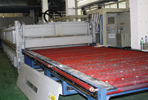
Glass producer gets tough on energy savings.
Clayton Glass UK’s core business is supplying the building trade with a variety of single or double glazed safety glasses. Safety glass is made by toughening glass in a process which is costly due to the amount of electrical energy required to heat and quench the material. All toughened and laminated products sold by Clayton Glass are manufactured to BS 6206 and carry permanent marking as certification; therefore, products need to conform to the highest quality standards.

According to PSY Systems’ Paul Young, the existing heating and movement controls were unsupported and proprietary based and were therefore replaced in the previous shutdown with the latest ABB AC800M control system.
“This upgrade on the blower quenching controls completed the system with respect to total control integration, support and backup. Glass quenching is performed by two large 315 kW blowers with air flow through the blowers regulated via vanes that open and close. This methodology is extremely inefficient, but widely used as component costs are relatively inexpensive,” says Young.
He explains that the client needed a more energy efficient system. “Fortunately management was able to grasp the opportunities offered by improving efficiency in the most energy costly division – the glass toughening section. This change was initiated because of rapidly rising energy, production flexibility limitations and the threat from European competitors. In this business all products are routed through the toughening machine before being dispatched to the market, so reliability is critical.”
Young says that the justification and decision making had to come from various divisions for the upgrade to take place. The end result had to benefit all areas. “Naturally, for the owners and shareholders electrical energy saving was high justification, but not the only priority.
“For production, there needed to be the flexibility to select one or two blowers depending on requirements. Previously, restarting blowers (start delta 315 kW motor) had to be carefully scheduled once per day. There are two cost models involved in running the production lines: firstly, when manufacturing is in progress, and secondly, during the idle times of tea and lunch breaks and shift changes.”
Young explains the overall benefit to the client: “With glass toughening, there are two high electrical energy consumption areas – heating and quenching. When manufacturing is in progress, electrical energy saving is achieved due to the blowers only running when the quench cycle is required. Further electrical energy savings are achieved due to different glass thickness requiring different quenching pressures – the thicker the glass the lower the pressure.
“Therefore the controller will lower the blower speed to regulate the required quench pressure. During the unproductive times, blowers will be at standstill with zero electrical energy required. Prior to the quench blower upgrade, blowers would run at full speed with the vanes closed, using 50% electrical energy (2 x 315 kW/2). As for the heating, electrical energy consumption is minimised naturally due to there being no glass in furnace, with the only energy required being that to keep the furnace at operational temperature.”
The maintenance department benefits because the soft starting of the motors reduces wear and tear on the blower mechanical parts like drive belts and bearings.
The upgrade implementation was carried out by removing the existing start delta switchgear control panels and installing and cabling the new ABB ACS550 inverters, integrated with the recently upgraded ABB controls to regulate air flow regulated via motor speed.
The upgrade has provided the client with electrical energy saving, production flexibility, mechanical longevity and the latest control equipment with support and backup.
“While pumps and fans are energy guzzlers they also have great energy saving potential and targeting applications like these within factories is a great start for any energy saving programme. Most paybacks are achieved within eight to 12 months of installation,” concludes Young.
For more information contact Paul Young, +27 (0)11 782 5449, PSY Systems, [email protected], www.psysystems.com
| Email: | [email protected] |
| www: | www.actionindustries.co.za |
| Articles: | More information and articles about PSY International |

© Technews Publishing (Pty) Ltd | All Rights Reserved